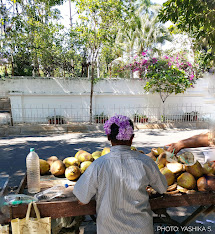BELLE IN SOUTH INDIA: A floral metaphor
As the morning rays of the day seep into the South-Indian localities, the hair of the ladies glistens with a string of gleaming flowers. It is quite common in the south of India to see women with flowers, particularly jasmine, in their hair.
I noticed a string of December flowers strung all around the bun of a lady selling coconut water right outside the Pondicherry Museum's main entrance. With the exception of men selling coconut water in the country, perhaps this lady with flowers in her bun knows how to shine in her own virtue. Somehow this insignificant event simply brightened my day.
Many ladies in South-India wear a string of sparkling jasmine blossoms in their hair as a symbol of good fortune. The flower may be seen in temple carvings and paintings, and jasmine themes and patterns can be found in traditional local jewellery, notably necklaces, earrings, anklets, and bangles. Hindus garland their deities with the blossoms, and no wedding ceremony in the region is considered complete without the white buds adorn practically every inch of the wedding hall.
In Ayurvedic practices, jasmine is said to soothe the mind by absorbing heat from the head through the hair, and the aroma is said to create feel-good brain chemicals that stimulate energy and reduce stress.
Although there are several jasmine kinds in Tamil Nadu, Madurai Malligai is very popular, both locally and globally. Its waxy, white, rectangular blooms are far more fragrant than other varieties, and the thicker petals may retain moisture and remain fresh for up to two days. The variety obtained a Geographical Indication (GI) tag in 2013 as a result of the efforts of agriculturalists and campaigners., legalising it and ensuring its quality.
The business of stringing flowers, on the other hand, is significantly more intricate like the String theory.
In her article "India's Auspicious Flowers," Kamala Thiagarajan describes how women Jasmine pickers in Maduria begin their job as early as sunrise, " when the flowers are collected, they are promptly wrapped in cane or jute baskets and sent to Madurai's open-air flower market and other places. The blossoms are sent throughout the world, wrapped in ice to maintain their freshness, with some ending up at high-profile perfumeries like Dior and Chanel to be crushed for their sweet essence." It is apparent that women are the backbone of this sector, from picking to selling to adorning it as a consumer.
Dr. Uma Kannan, a social and cultural anthropologist and author of "Madurai Malligai: Madurai and Its Jasmine - A Celebration," says "the workers who pick and string jasmine flowers, sell them on the streets, and do the more mundane jobs are women, but those who sell in larger quantities, cornering the lion's share of the profits, are men."
While the majority of the flower merchants are female and sell their jasmine strands from temporary platforms at the market's entrance, the primarily male commission brokers negotiate big amounts directly with local farmers. Efforts to eliminate the middleman have not always been fruitful. Even when the women combine their resources and buy in bulk, they are sometimes unable to compete with the cash-rich brokers, many of whom advance huge sums of money to farmers and thus have greater control over the production process.
Small farmers, who are continuously in need of money for fertiliser, seed, and other necessities, benefit from the advances of an agent. A system that has been in place for more than three decades. Some practises, such as garland creation, are rarely taught to women since they are a closely kept secret in the male stronghold.
The way these ladies take this inequality in stride, performing this labour, and how beautifully they adorn it as though the pleasant aroma of flowers seeps into their own personality, is astonishing. However, in order to continue blossoming, a flower needs its thorns to safeguard itself. According to reports, certain foundations, such as DHAN, have helped educate more than 250 women to sell flowers for a living, as well as set up microfinance programmes to help them access bank loans and other assistance. There is optimism that things will improve if female flower merchants are given external knowledge, work as an unified front, receive extra training to become more conscious of their rights and vulnerabilities.
References
Kannan, U. (2019). Madurai Malligai - Madurai and Its Jasmine (A Celebration) (2019th ed.). Thiagarajar College, Publication Division, Tamil Nadu.
Thiagarajan, K. (n.d.). India’s auspicious flowers. BBC Travel.



"The business of stringing flowers, on the other hand, is significantly more intricate like the String theory." -- Great contrasting correlation by the author.
ReplyDeleteTo see beyond the ordinary, what wonderful eyes must the author possess.
ReplyDelete